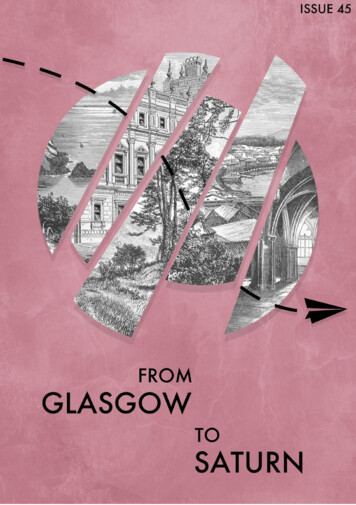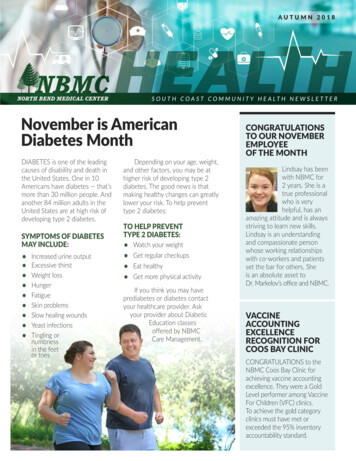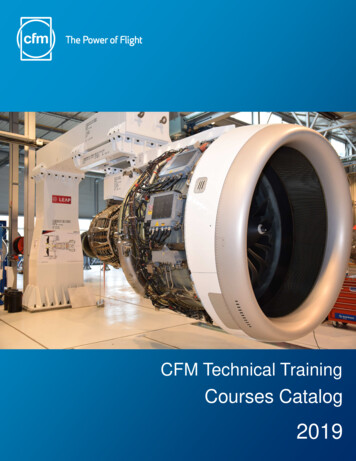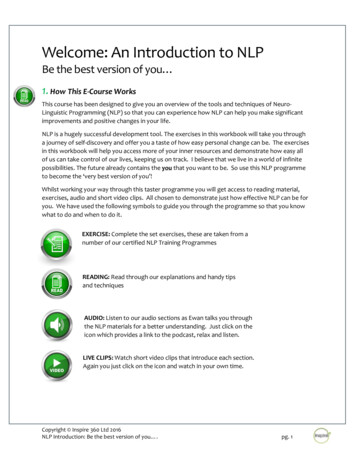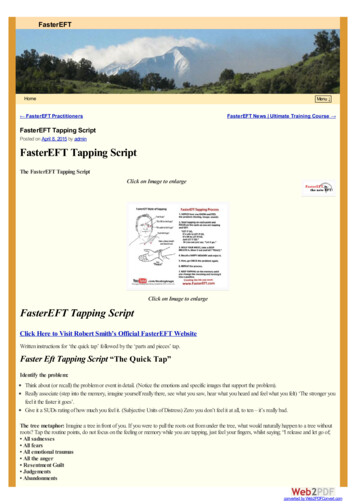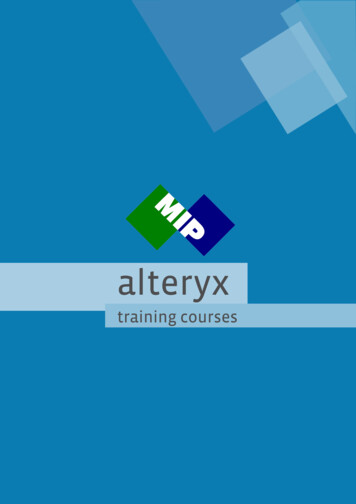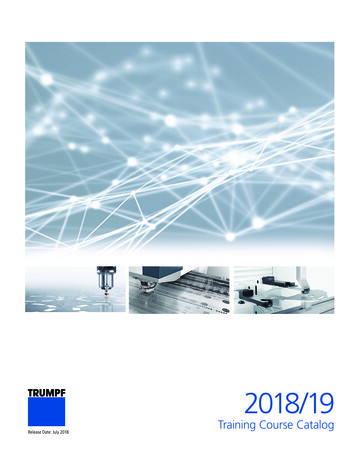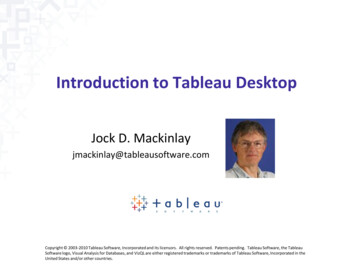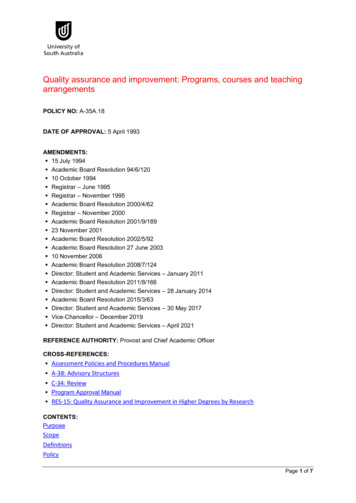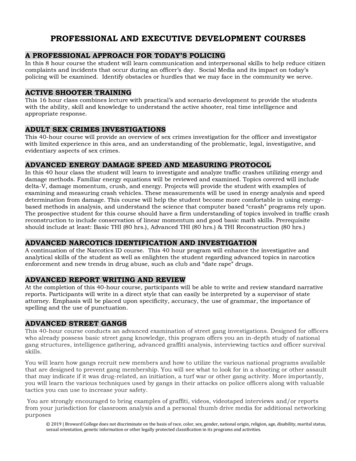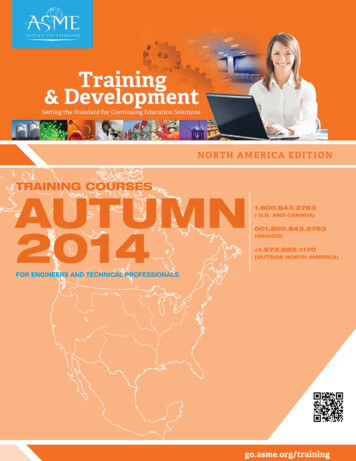
Transcription
NORTH AMERICA EDITIONTRAINING COURSESAUTUMN20141.800.843.2763( U.S. AND CANADA)001.800.843.2763(MEXICO) 1.973.882.1170(OUTSIDE NORTH AMERICA)FOR ENGINEERS AND TECHNICAL PROFESSIONALSgo.asme.org/training
Welcome to the worldof ASME Training &DevelopmentASME appreciates that a company’s most valuable asset is its workforce. As a recognized leader in workforcelearning solutions for engineers and technical professionals, our goal is to help individuals expand theirknowledge and organizations develop their core assets.Our guiding principles are reflected in the depth, breadth and quality of highly accessible courses andtraining programs, specifically developed to boost technical competence and heighten managerial expertise.All ASME Training & Development programs are delivered by ASME-approved instructors who arerecognized experts within their professional disciplines. Importantly, most code courses are developed andtaught by ASME Code Committee members who understand and can communicate code or standardrelevance and their impact on safety, quality and integrity.Explore the wide range of learning solutions that will help you handle the demands of today’s increasinglychallenging environment, presented in training formats that best fit your business needs and meet your budgetand time constraints: Public Courses – Discover more than 100 courses ranging from fundamental to advanced levels, allled by industry experts eLearning Courses – Browse our comprehensive portfolio of over 100 different eLearning programsfeaturing instructor-supported and self-study online learning – each available from a PC with Internetaccess anytime, anywhere Seminars and Workshops – Explore intensive industry-specific events focusing on short presentationscovering the latest technologies and their real-world applications In-Company – Select from any of our courses to create a customized training program delivered atyour company’s site, anywhere in the worldIf you are looking for a topic but don’t see it in these pages, please let us know. ASME Training & Developmentis continually developing new courses to meet constantly changing professional and industry needs.ABOUT ASMEASME Training & Development has beenaccredited as an Authorized Provider bythe International Association for ContinuingEducation and Training (IACET). In obtainingthis approval, ASME Training & Developmenthas demonstrated that it complies with theANSI/IACET Standard which is recognizedinternationally as a standard of good practice.Their Authorized Provider status, ASMETraining & Development is authorized to offerIACET CEUs for its programs that qualifyunder the ANSI/IACET Standard.ASME helps the global engineering community developsolutions to real world challenges. Founded in 1880 asthe American Society of Mechanical Engineers, ASME isan international not-for-profit professional organizationthat enables collaboration, knowledge sharing and skilldevelopment across all engineering disciplines, whilepromoting the vital role of the engineer in society.For over 130 years, ASME codes and standards,publications, conferences, continuing education andprofessional development programs have provided afoundation for advancing technical knowledge and asafer world.For more information visit: www.asme.orgFOR COMPLETE COURSE DESCRIPTIONS AND TO REGISTER, VISIT GO.ASME.ORG/TRAINING OR CALL 1.800.843.2763
1TABLE OF CONTENTSBoilers and Pressure Design and Materials.16Elevators and Escalators.22Fluids and Heat Transfer.24GasTurbines.30Geometric Dimensioning and Tolerancing.32Legal Issues for Engineers.35Managing People.36Managing Projects.40Nuclear.44Ocean, Offshore and Arctic Engineering.56Petroleum.59Piping and Pipelines.60Process Safety.72Rick and Reliability.74Welding.78ASME MasterClass Series.80ASME eLearning Courses.84Instructors.86ASME Autumn 2014 Public Course Calendar and Index.90ASME In-Company Training Programs.95Venues and Hotels.96General Information.Inside Back CoverSpecial Offer toNon-ASME MembersAttendees of any ASME Training& Development public coursesregistered as non-ASMEmembers will receive aFREE one-year membershipto ASME following submissionof an application form availableat the program.All ASME members will continueto enjoy special “Member Only”discounts off the List Price on mostASME Training & Developmentpublic courses and elearningprograms.Statements made by thespeaker do not necessarilyrepresent the position of ASME.No recording or videotaping maybe conducted by theparticipants without consentfrom ASME.ASME Training &Development Autumn 2014eCalendar Now AvailableDownload the FREE Autumn 2014 ASME Training &Development eCalendar listing dates and locations ofLive Course offerings in North America and Europethrough December 2014, as well as eLearning Coursesavailable worldwide, from a PC with Internet access,any time,Visit:go.asme.org/autumntrainingor scan with a smart device:ASME does not assumeresponsibility for any missingor damaged articles for any ofits registrants. Registrants areresponsible for all personalbelongings during the length ofthe course while in hotel meetingrooms – this includes all breaks,lunch and overnight.All requests for training recordsinformation is processed bythe ASME Customer Caredepartment. All records of courseenrollment and completion arestored in the ASME database andare available to the student bycontacting ASME Customer Careat customercare@asme.org.Copyright 2014 ASME AmericanSociety of Mechanical Engineers.All rights reserved, includingconversion to other media.visit go.asme.org/training
TAKE THIS COMBO COURSE AND SAVE UP TO 645!INSPECTIONS, REPAIRS ANDALTERATIONS OF PRESSUREEQUIPMENTPD443PD441BPV CODE, SECTION VIIIDIVISION 1 COMBO COURSEASME CODE COURSETOP SELLERCreated to save participants time and money, this course is a back-toback offering of “Section VIII, Division 1 - Design & Fabrication of PressureVessels” (PD442) and “Inspections, Repairs, and Alterations of PressureEquipment” (PD441). If you opt to take this combination course, youcould save up to 645.INSTRUCTOR: Kamran Mokhtarian 5 Days, 3.8 CEUs, 38 PDHsMEMBER 3,050 / List Price 3,150BPV CODE, SECTION VIII,DIVISION 1: DESIGN ANDFABRICATION OF PRESSUREVESSELSPD442ASME CODE COURSETOP SELLERBased on the rules for pressure vessel design and construction, this course isa comprehensive introduction to the requirements of Section VIII, Division1 including background, organization, design, materials, fabrication,inspection, testing and documentation of pressure vessels. It coversthe more commonly applied subsections and paragraphs, and includesa practical discussion of individual problems and situations. Designedprimarily for beginners, experienced vessel designers, who would like toupdate their knowledge of the Code, will also benefit.BO ILERS AND PR ESS UR E VESSELSSpecial features include: an overview of Code organization,offering of updated editions, and expert instruction on how toprepare and submit an inquiry to the Code Committee for CodeInterpretation, Code Cases or Code Revision.You Will Learn To Describe the background of the Code Explain how to apply the Code rules to more common design andfabrication situations Identify the calculations for some of the loadings and situations notaddressed by the Code Describe the preparation of design specifications, design reports,data reports and other documentationWho Should AttendASME CODE COURSETOP SELLERThis course is a comprehensive introduction to the requirements of variouscodes and standards regarding inspection, repairs and alterations ofpressure equipment, and in particular, pressure vessels. The requirementsof the National Board Inspection Code and the API-510 will be coveredin detail. A brief introduction to API-579, Fitness-for-Service will also beincluded. Simple flaw evaluation procedures will be evaluated. The activitiesof ASME’s Post Construction Committee will be explained and documentspublished by this Committee will be discussed.You Will Learn To Describe the latest developments in the rapidly advancing field of pressureequipment inspection and repairs Identify the work being performed by API, ASME, and PVRC in the relatedareas. Identify the post-construction Codes and Standards and the interrelation ofvarious documents Explain the responsibilities of the users, manufacturers, repairorganizations, regulatory agencies and authorized inspectors Explain how to obtain a National Board stamp Identify detailed requirements of the NBIC Explain the differences between the NBIC and API-510 Identify and provide examples of repairs, alterations and thedocumentation requirements for each Describe introductory portions of the ASME post-construction standards Provide examples demonstrating the application of the rulesWho Should AttendIndividuals from users, manufacturers, repair organizations, inspectionagencies and other organizations involved with maintenance and repairof pressure equipment. This course is intended for beginners, as well asexperienced personnel wishing to update their knowledge.INSTRUCTOR: Kamran Mokhtarian2 Days, 1.5 CEUs, 15 PDHsMEMBER 1,535 / List Price 1,645Save up to 645 by enrolling in PD443, a combo course consisting ofthis course (PD441) and PD442, “BPV Code: Section VIII, Division 1 Design & Fabrication of Pressure Vessels.”Also available as Online Instructor-Supported course EL503.Those involved with the purchase, design, fabrication or inspectionof pressure vessels. Some technical background will be helpful, butattendees are not required to have an engineering degree or previouswork experience in the subject matter.Special RequirementsA calculator is required. It is suggested (but not required) thatparticipants bring the latest edition of the ASME codebook, BPVCSection VIII - Rules for Construction of Pressure Vessels Division 1.INSTRUCTOR: Kamran Mokhtarian 3 Days, 2.3 CEUs, 23 PDHsMEMBER 2,050 / List Price 2,150Save up to 645 by enrolling in PD443; a combo course consistingof this course (PD442) and PD441, “Inspection, Repairs, andAlterations of Pressure Equipment.”Also available as Online Instructor-Supported course VISITGO.ASME.ORG/EUROPE OR2 743 ITGO.ASME.ORG/TRAININGORCALLCALL 321.800.843.2763
3BPV CODE, SECTION VIII,DIVISION 2: ALTERNATIVE RULES– DESIGN AND FABRICATION OFPRESSURE VESSELSPRESSURE RELIEF DEVICES:DESIGN, SIZING,CONSTRUCTION, INSPECTIONAND MAINTENANCEPD448PD583ASME CODE COURSETOP SELLERThis course provides a practical comparison of the new rules with theformer rules of Division 2. It also covers other international codes, includinga discussion of why the new requirements were instituted; this courseexplains the design margins and their effect on required thickness. Whileemphasizing design and analysis rules, it covers all aspects of construction.You Will Learn To Explain how the requirements of Divisions 1 and 2 of Section VIII compare Explain theories of failure and design margins of various codes Describe the general requirements of the new Division 2 Identify design rules and stress analysis methods Describe fatigue analysis Identify materials and fabrication requirements Explain Nondestructive Examination (NDE) requirements, pressure testingand pressure relief requirementsWho Should AttendIndividuals involved with design, analysis, fabrication, purchasing, repair, andinspection of pressure vessels should attend, as well as supervisory andregulatory personnel. Although some degree of background with designand fabrication of pressure vessels is desirable, no previous experienceis required for attending this course. Both the beginners and experiencedpersonnel involved with pressure vessels will benefit from this course.INSTRUCTOR: Kamran Mokhtarian4 Days, 3 CEUs, 30 PDHsMEMBER 2,550 / List Price 2,750Each participant will receive a copy of the ASME codebook, PTC 25 - 2008 Pressure Relief Devices; and a copy of the book, PressureRelief Devices: ASME and API Code Simplified, by Dr. MohammadA. Malek.The code requirements for pressure relief devices are covered by thefollowing ASME Boiler and Pressure Vessel (B&PV) Codes:ASME Section I – Power BoilersASME Section III – Nuclear SystemsASME Section IV – Heating BoilersASME Section VIII, Div. 1 – Pressure VesselsASME Section XII – Transport TanksASME B31.1 – Power PipingYou Will Learn To Explain the Code requirements for pressure relief devices covered by theASME Boiler and pressure Vessel Code Describe the API RP 520 Part I, Sizing and Selection of PressureRelieving Devices, and API RP 520 Part -2, Installation of PressureRelief Devices Explain the construction and installation processes Identify the requirements for testing and testing facilities Describe the records and maintenance and the VR (valve repair)certification programWho Should AttendProcess engineers, testing and inspection personnel, maintenance andreliability engineers, managers and operatorsDid youknow.INSTRUCTOR: Mohammad Malek2 Days, 1.5 CEUs, 15 PDHsMEMBER 1,535 / List Price 1,645Evalution surveys completedby attendees after each ASMEPublic Course over the pasttwo years indicate that97%rate the course they attendedas “very or extremelyrelevant to my job.”* ASME Course Evaluation Survey completed betweenJuly 2011 and June 2013 by 4,401 participantsvisit go.asme.org/trainingBOILERS AND PR ESSU RE VESSE LSAlso available as Online Instructor-Supported course EL502.ASME CODE COURSEPossibly the most important single safety device on a boiler or pressurevessel, the pressure relief device is all that stands between overpressureconditions and catastrophic explosions. This comprehensive review of thedesign, construction, installation, operation, inspection and maintenanceof pressure relieving devices currently in use on boilers and pressurevessels details how to protect pressurized equipment from exceeding themaximum allowable working pressure.
BPV CODE: PLANTEQUIPMENT REQUIREMENTSTURBO MACHINERYDYNAMICS: DESIGN &OPERATIONPD622PD432ASME CODE COURSEThis 4-day course provides comprehensive instruction on design,fabrication and operation requirements for pressure vessel, boiler, steamgenerator and associated equipment. The Code provides the ownerthe option to extend Code rules beyond pressure vessel boundarylimits to attached mechanical equipment. The list includes pressurizedcomponents, welded and bolted flange connections.The course focuses attention on a wide range of topics, includingdesign, material and manufacturing responsibilities for Code compliance,circulation in and design of boiler evaporator, superheater, economizer,heat balance in waste heat recovery steam generator, furnace chamberdesign and boiler safety attachments, boiler tube toughness, corrosionresistance, affinity laws, performance curves, efficiency, proportionalflow and safety valve control mechanism, bolted flange pre-load, jointbehavior, leakage, welded joint pre- and post-weld heat treatment,distortion, cracking, NDE (nondestructive examination) test requirements,as well as over-pressure and over-speed tests.You Will Learn To Understand design procedures for components for structural integrity,superior efficiency, reduced exhaust pollution Explain hydraulic, thermal, and fluid theories Gauge severity of operating loads and mitigate unwelcome failures dueto pressure surge, cavitation, water hammer and other rapid energytransfer mechanismsWho Should AttendBO ILERS AND PR ESS UR E VESSELSIndividuals responsible for design, purchase, manufacture, inspection andsales of plant equipment. Some technical background will be helpful, butan engineering degree or work experience is not needed.Special RequirementsIt is recommended that participants bring a laptop to the course.INSTRUCTOR: Abdulla Rangwala4 Days, 3 CEUs, 30 PDHsMEMBER 2,550 / List Price 2,750This course presents a detailed and comprehensive treatment of operationand maintenance of turbo-machinery.Starting with the fundamentals of thermodynamics and cycle design, thelatest trends in development and production of many different types ofturbo-machines are covered. In-depth methods to analyze and explore newoperation and maintenance procedures, minimize exhaust emissions andmaximize structural integrity and operating efficiency are presented.The ever-increasing quest for electrical and mechanical power, coupledwith stricter restrictions on environmental pollutants, require exactingconsideration of natural resources. Creative technological solutions areneeded to optimize operation and achieve, often times, conflicting goals.This course teaches methods, which help one understand the wide rangeof parameters, as well as how to take advantage of the latest technicaladvances. Emphasis is placed on controlling operating parameters,interpreting and comparing alternatives, and obtaining realistic solutions.Specially prepared notes and the instructor’s textbook,Turbo-Machinery Dynamics: Design and Operation will be providedto all participants on a computer disk, as well as a bound copy ofthe course notes. The electronic notes and textbook are linked forinstant access and in-depth study from the notes directly to thespecific page of the book through electronic bookmarks. Attendeeswill also receive computer codes with instructions for simulating andanalyzing rotating machinery problems, parameter measurementand balancing of rotors.You Will Learn To Describe fuel consumption, power output, and exhaust gas emissions Explain structural integrity and component life evaluation Identify operating loads, component deflections, rotor-to-stator rub Explain the process of manufacturing and assembly methods, balancingof rotors Explain the test verification of design parameters and fault diagnosis Identify failures arising from cyclical loads and thermal distortion Identify material requirements and selectionWho Should AttendDesign and development engineers, plant engineers,field service engineersand techn
This course is intended for beginners, as well as experienced personnel wishing to update their knowledge. INSTRUCTOR: Kamran Mokhtarian 2 Days, 1.5 CEUs, 15 PDHs MEMBER 1,535 / List Price 1,645 Save up to 645 by enrolling in PD443, a combo course consisting of this course
